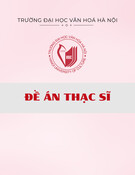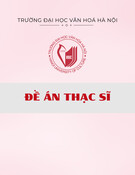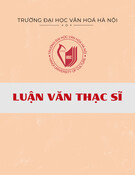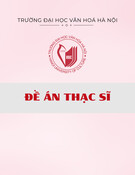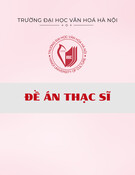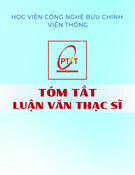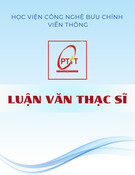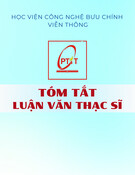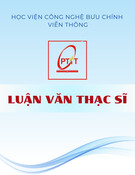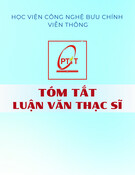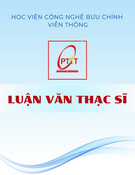1 2
6. The structure of the thesis INTRODUCTION Apart from the introduction and conclusion, the thesis is structured into 5 chapters as follows: 1. The reason for choosing the topic Chapter 1: Theoretical basis The tobacco industry is not a spearhead economic sector of Vietnam, but contributes to a huge budget Chapter 2: Overview and research model for Vietnam. As a conditional business sector by the Tobacco Control Law, visual health warnings have a Chapter 3: Research methodology strong impact on consumers' psychology and behavior. Up to now, Vietnam's tobacco industry, typically 4 Chapter 4: Research results corporations (Vietnam Tobacco Corporation - Vinataba, Khanh Viet Corporation - Khatoco, Sai Gon Chapter 5: Discussion of research results and recommendations industrial corporation - CNS, Dong Nai Food Industry Corporation - Dofico) with a total of 122 companies stretching from the North to the South, including dependent companies, parent-child groups, member CHAPTER 1. THEORETICAL BASIS companies, joint-stock companies, joint-venture companies, associate companies. The four corporations have 1.1. Middle managers in the enterprise a total of 232 middle-level managers with an average age of 40 years. Corporations have carried out the work of personnel planning annually according to regulations. However, up to now, corporations have not yet 1.1.1. The concept of middle managers developed a title standard for managers. The recruitment and appointment of managers is mainly based on Middle managers in the enterprise are the managers who perform management activities below the senior the criteria for general staff appointment specified in the staff appointment regulations, many of which are managers but above the grassroots administrators or the executive staff. still qualitative. Therefore, the management team of tobacco enterprises in general is still familiar with the 1.1.2. The role of middle managers in the enterprise management regime of subsidies, not really breaking through and integrating with the market mechanism. Middle manager is an indispensable team for any enterprise. Their important role manifests in the following aspects: the role of information transmission, decision-making role, advisory role. , advising, management role, negotiating role. Therefore, the current problem is the management capacity of the middle management team of Vietnamese tobacco enterprises at what level and can meet what percentage of the needs of globalization and international economic integration. For the above reasons, the author has chosen the topic "Factors affecting 1.2. Management capacity of middle manager 1.2.1. Concept of enterprise management capacity the management capacity of middle managers in tobacco enterprises in Vietnam" for my thesis. 2. Objectives of the study 1.2.2. Concept of management capacity of middle manager The objective of the thesis is to quantify the influence of factors on the components of management The management capacity of the middle manager is the combination of the characteristics, capacity of middle managers in tobacco enterprises in Vietnam, on that basis, recommendations are made to knowledge and behavior of the middle manager individual in coordination practice, establishing the relationship of the resources of the responsive business and ensure the business activities to meet the further improve the management capacity of middle managers in tobacco enterprises in Vietnam in the coming time. requirements set out in the present, paving the way for the future operation of the business. 3. Object and scope of the study 1.2.3. Framework of management capacity of middle manager 1.2.4. Factors constituting the management capacity of middle managers in enterprises 3.1. Research objects: The object of the thesis is the factors affecting the management capacity of middle managers in tobacco businesses in Vietnam. 1.2.4.1. Management quality (BE) Management qualities are the specific personal characteristics needed that can attract, influence, 3.2. Research scopes - About content: In the scope of this thesis, the author only limits research to the level of management make others listen and follow. In other words, these are the personal qualities of a manager, in order to capacity of middle managers in tobacco enterprises in Vietnam.. distinguish one manager from another. Individual qualities can be positive or negative. 1.2.4.2. Management knowledge (KNOW)
- About space: studying 4 corporations operating in the field of tobacco in Vietnam (Vinataba, Khatoco,
Management knowledge is the scientific knowledge and understanding of managers in order to serve CNS, Dofico). the management and administration of enterprises that they study or accumulate in the process of enterprise
- About time: Secondary data was collected until June 30, 2019, primary data was collected from October
management. For middle managers, they need to have the following management knowledge: knowledge 2018 to May 2019 and the proposed solution was to 2025. about the business lines of the business they are managing, knowledge about business strategy management, 4. Research methods knowledge about human resource management, knowledge of financial and accounting management, knowledge of production and business management, knowledge of technology management, knowledge of The thesis uses a combination of two research methods: qualitative research methods and quantitative marketing management ... research methods. 5. New contributions of the thesis
3 4
1.2.4.3. Management actions (DO) 2.1.3. The researches on the factors affecting the management capacity of business management team Management actions are what middle managers do in specific management situations (actions that When studying the factors affecting the management capacity of the management team in managers often perform in certain situations, even forming a management style). These management actions are concretized by the 5 main actions of any manager in the enterprise: modeling for subordinates, accepting challenges, creating shared visions, developing employees, blood transfusion. enterprises, there are many domestic and foreign researches such as: Kontoghiorghes, C. and Neophytou, A. (2011); Abigail Redic et al (2014), Das,V.T. and Amala,G. (2016), Do Anh Duc (2015), Luu Ngoc Hoat (2015), Truong Hong Vo Tuan Kiet and Lam Huon (2015), Le Thi Phuong Thao (2016).... 1.3. Factors affecting the management capacity of middle managers in enterprises 2.2. Research models 2.2.1. Research gaps 1.3.1. Group of factors inside the enterprises An overview of domestic and foreign researches shows that there have been many researches on the - The middle managers themselves are the factors within the enterprise, which are crucial for the formation management capacity of senior or middle managers in enterprises. The author focuses my research on the and career development of each administrator. It is noticeable that personal factors directly affect the factors affecting the management capacity of middle managers in tobacco businesses in Vietnam in order to formation and development of management capacity of middle managers in enterprises. Factors that belong study a part of the gaps in previous studies. to middle managers themselves include: Health, age, qualifications, work experience, qualities, innate 2.2.2. Proposal of research model talents, family traditions…. - Factors that belong to the characteristics of the enterprise: size of the enterprise, type of business, its operations, organizational structure of the enterprise ….
- Factors from senior managers and subordinates. - Cultural environment in the enterpise.
AFFECTING FACTORS
- Mechanisms and policies of the enterprise.
MANAGEMENTCAPACITY
H1
Middle managers themselves
Management quality
1.3.2. Group of factors outside the enterpise Economic environment; political and legal environment; cultural and social environment; scientific,
H2
Mechanisms and policies of the enterprise
technical and technological environment; competition in the market.
H3
Management knowledge
Directional decision of senior managers
CHAPTER 2. OVERVIEW AND RESEARCH MODEL
H4
Management actions
Competence of subordinates
2.1. Research overview
H5
Competition in the market
2.1.1. The researches on the components of enterprise management capacity The topic "Enterprise management capacity" is a topic that has been studied a lot in the world, in which many related issues have been discussed and agreed. However, there are still many different perceptions about management capacity as well as elements of enterprise management capacity depending on the views of each author. In order to focus on the research content of the thesis, the author has Figure 2.3. Research model of the thesis researched domestic and foreign studies related to the components of enterprise management capacity Source: Author's proposal such as: Richard. E.Boyatzis (1982), Kerstin Keen (2000), Tran Thi Van Hoa (2009), Le Quan (2011), Le 2.2.3. Research hypotheses Quan and Nguyen Quoc Khanh (2012), Do Anh Duc (2015)....
2.1.2. The researches on management capacity of middle managers in enterprises CHAPTER 3. RESEARCH METHODOLOGY There have been many researches on management teams in the enterprise, most of which are focused 3.1. The research process of the thesis on senior managers with very few studies paying attention to the role of middle managers in the enterprise. The research process of the thesis consists of 7 steps as follows: However, when researching the middle managers in enterprises, the authors' research include: Floyd, S.W Step1: Determining research objectives: the main research objective of the model is to measure the influence of factors on the management capacity of middle managers of tobacco enterprises in Vietnam. and Wooldridge, B (1990, 1992, 1997), Xu Hong-Hua and Wang Yan-Hua (2009), Cavazotte F., Moreno V., Hickmann M (2012), Tran Thi Van Hoa (2009), Do Vu Phuong Anh (2016), Doan Xuan Hau (2016).
5 6
3.4.1.2. Selecting the survey sample Step2: Overview of research on enterprise management capacity, factors affecting enterprise management capacity, management capacity of middle managers in enterprises. 3.4.1.3. Testing scales Step 3: Building a theoretical framework on: Factors affecting the management capacity of middle managers and the components of management capacity of middle managers. The scale test was performed by Cronbach's Alpha reliability coefficient analysis method and Exploratory Step 4: Building and adjusting the scales. Factor Analysis (EFA) to screen and remove observed variables that did not meet the standard, also known Step5: Preliminary quantitative research to assess scales with small sample sizes. as is turning garbage. Step6: Official quantitative research: conducted through testing scales and hypotheses using confirmatory 3.4.1.4. Testing the suitability of the model factor analysis (CFA), checking the appropriateness of the research model using SEM tool and Test estimation model by Bootstrap method. After performing Cronbach's Alpha reliability coefficient analysis and Exploratory Factor Analysis Step7: Discussing the results of the study, and then recommend recommendations to improve the (EFA), the model continued to be tested by CFA (Confirmatory Factor Analysis) to verify the conformity of measurement model with market data. 3.4.2. Official quantitative research management capacity of middle managers in tobacco enterprises in Vietnam. 3.2. Data sources and data collection methods 3.3. Qualitative research methods From the results of testing the model's suitability with market data through the Confirmatory Factor Analysis (CFA), the official quantitative research process was conducted by the author through the process 3.3.1. The expert method of testing the influence of five factors on the management capacity of middle managers in tobacco The expert method is used by the author to build and adjust the draft scales for the independent and enterprises in Vietnam. The method used by the author in the official quantitative research is analysis of dependent variables of the model from which to build the official scale for quantitative research. linear structure model (SEM). 3.3.2. The individual interview method The objective of the individual interview method is to adjust the content of the draft scale designed CHAPTER 4. RESEARCH RESULTS from the results of the above-mentioned expert method to complete the official scale used for quantitative research.. 3.4. Quantitative research method 4.1. Research results of current management capacity of middle managers at tobacco enterprises in Quantitative research methods are used to quantify the relationship between variables in the research Vietnam model and test the research hypotheses obtained from theory through the use of statistical analysis tools. The 4.1.1. Overview of middle managers at tobacco enterprises in Vietnam quantitative research process is divided into 2 phases: preliminary quantitative research and official Up to the present time, Vietnam's tobacco industry has a total of 232 middle managers with the following quantitative research. characteristics: age, gender, education level, seniority and management experience. 3.4.1. Preliminary quantitative research 4.1.2. Situation management capacity of middle managers in tobacco enterprises in Vietnam 4.1.2.1. Management quality (Be) The author conducted a preliminary quantitative study to check the reliability of the scales, thereby All positive management qualities are assessed at a good score from 3.24 points to 3.67 points. In eliminating the inappropriate observable variables (if any) from which to build a complete system of scales which the quality of "Sensitive to business opportunities in the market" of middle managers is assessed with for official quantitative research. The preliminary quantitative research process is as follows: the highest score of 3.67 points. For the negative qualities, all the survey subjects rated at a level lower than 3.4.1.1. Designing the survey questionnaire the average positive qualities below 3.0 points. 4.1.2.2. Management knowledge (Know) Management knowledge of middle managers of Vietnamese tobacco enterprises is not good, the lack of some management knowledge of this team has caused them to have no accurate understanding of the nature of management activities as well as effective management decisions. This directly affects the business performance of the business. 4.1.2.3. Management action (Do) Management actions of middle managers at tobacco enterprises in Vietnam have not created the absolute consensus of the staff and employees in the enterprise. The lack of attention to employee development should partly affect the performance of the enterprise.
7 8
4.1.3. General assessment of middle managers and management capacity of middlel managers at tobacco <0.05), and the KMO coefficient = 0.673 > 0.6. This proves that the factor analysis results to group the enterprises in Vietnam variables together to ensure reliability. 4.1.3.1. General assessment of middle managers
- The coefficient of total variance of 05 factors is 75,379, showing the variation of factors given by the analysis can explain 75.379% of the variation of the original survey data. The value of variance is greater
4.1.3.2. General assessment of management capacity of middle managers than 50%, so it also guarantees the analysis required. With the survey results in 4 typical tobacco enterprises in Vietnam, it shows that the middle managers at
- Eigenvalues factor of the fifth factor is 1,088> 1, proving that the data obtained has good
these 4 enterprises fully converges on the level of professional knowledge and capacity to be able to manage convergence, confirming that there are 05 factors drawn from the analysis. subordinates and with the CEO team to steer the boat of their enterprises to success. 4.2. Research results on factors affecting the management capacity of middle managers at tobacco c. Confirmatory Factor Analysis (CFA) enterprises in Vietnam The results of CFA analysis of the criteria to measure the suitability of the model shown in Figure 4.1 show: 4.2.1. Results of survey screening Chi-square / df value = 1,474 < 3, TLI = 0.987 > 0.9, CFI = 0.991 > 0.9, NFI = 0.973 > 0.9, GFI = 0.982 > As presented in the research method, with 4 objects to be investigated are senior managers, middle 0.9, RMSEA coefficient = 0.027 < 0.08; These values show the model is consistent with market data. managers, low level managers and staff; The author conducted a survey of 713 people and collected 687 Moreover, the P-value results of the observed variables representing all factors have a value of 0.000, the questionnaires and then filtered out 668 valid surveys. standardized weights of the scales are high (> 0.5) so the observed variables are confirms the ability to 4.2.2. Results of sample analysis perform well for the factor in CFA model and high convergence scales. The data obtained from 668 questionnaires was used to conduct analysis to answer the research 4.2.3.2. Testing the scale of the components of management capacity of middle managers questions raised. After performing the data cleaning and processing of primary data through Excel software, the final data is entered into SPSS 25.0 software data to conduct analysis and evaluation. a. Analysis of Cronbach’s Alpha coefficients 4.2.3. Results of testing scales The results of the data analysis show that the scales measuring the components of the management capacity of middle managers including: management qualities, management knowledge, management actions all have 4.2.3.1. Testing the scale of factors affecting management capacity of middle managers Cronbach’s Alpha coefficient reaches a high above 0.6 (the "management quality" scale with Cronbach’s Alpha coefficient = 0.884, the ”Management knowledge” scale with Cronbach’s Alpha coefficient = 0.913, a. Analysis of Cronbach’s Alpha coefficients the ”management action” scale with Cronbach’s Alpha coefficient = 0.886), therefore the data is guaranteed Competence of subordinates reliability. Moreover, the correlation coefficient of the total variables of all observed variables with the factor that these variables represent is greater than 0.3. Therefore, the scales are concluded to ensure reliability. The results of data analysis show that: the scales for measuring the groups of factors affecting the Observed variables and factors are retained for further analysis. management capacity of middle managers at tobacco enterprises in Vietnam include: middle managers themselves, mechanisms and policies of the enterprise, directional decision of senior managers, competence b. Exploratory Factor Analysis (EFA) of subordinates, competition in the market have Cronbach's Alpha coefficient reaching a high level of 0.6 (In particular, the scale of the factor "Middle managers themselves" has Cronbach's Alpha coefficient = 0.847;
- Bartlett's test results show that: among the variables are correlated with each other (Sig = 0.000 <0.05), and KMO coefficient = 0.903 > 0.6 proves the results of factor analysis to group the
the scale of the factor “Mechanisms and policies of the enterprise” has Cronbach's Alpha coefficient = 0.804; variables together is the reliability guarantee. the scale of the factor “Directional decision of senior managers” has Cronbach's Alpha coefficient = 0.866; the scale of the factor “Competence of subordinates” has Cronbach's Alpha coefficient = 0.765; the scale of the factor “Competition in the market” has Cronbach's Alpha coefficient = 0.704). This shows that the survey
- The coefficient of variance of 03 factors is 56,797, showing the variation of factors given by the analysis can explain 56.797% of the variation of the original survey data. The value of variance is greater
data is completely reliable. Moreover, the correlation coefficient of the total variables of all observed than 50%, so it also guarantees the analysis required. variables with the factor that these variables represent is greater than 0.3. This shows that the respondents
- Eigenvalues factor of the third factor is 2.993 > 1, proving that the data obtained has a good
have the concept of the factor group given according to the observed variables expressing that factor, so the convergence, confirming that there are 03 factors drawn from the analysis. scale is built based on the appropriate observed variables. Therefore, the scales are concluded to ensure c. Confirmatory Factor Analysis (CFA) reliability. Observed variables and factors are retained for further analysis. The CFA analysis results of the measurement criteria of the model shown in Figure 4.2 show that Chi-square b. Exploratory Factor Analysis (EFA) / df value = 2.285 < 3, TLI = 0.965 > 0.9, CFI = 0.969 > 0.9, NFI = 0.947 > 0.9, GFI = 0.948 > 0.9, RMSEA
- Bartlett’s test results show that among the variables is correlated with each other (Sig = 0.000
coefficient = 0.044 < 0.08. These values show the model is consistent with market data. This result shows
9 10
CHAPTER 5. DISCUSSION OF RESEARCH RESULTS AND RECOMMENDATIONS that the observed variables representing three scales expressing management capacity including management qualities, management knowledge, management actions are suitable to represent these scales. 5.1. Discussion of research results 4.2.4. Model test results and research hypotheses through analysis of linear structure model (SEM)) In order to measure the influence of factors on the management capacity of middle managers in tobacco enterprises in Vietnam, the thesis has proposed 5 factors. The data processing results show that all The results of testing linear structure model (SEM) on factors affecting management capacity of middle five factors positively affect the management capacity of middle managers in tobacco enterprises in Vietnam, managers are as follows: including: the factor "Middle managers themselves" with coefficient is 0.306, the factor "Mechanisms and policies of the enterprise" with coefficient is 0.248, the factor "Directional decision of senior managers" with Table 4.14. The results of testing the influence of factors to middle management capacity coefficient is 0.239, the factor "Competence of subordinates" with coefficient is 0.181, the factor
S.E.
C.R.
P
Regression coefficient
"Competition in the market" with coefficient is 0.091.
0.306
NL_QL
<--- BT_QL
0.019
16.024
***
5.2. Recommendations
0.248
NL_QL
<--- CC_CS
0.018
13.450
***
5.2.1. Management quality (BE)
0.239
NL_QL
<--- QT_CC
0.014
17.024
***
To improve the management capacity of middle managers for tobacco enterprises in Vietnam based
0.181
NL_QL
<--- NV_CD
0.019
9.565
***
on management qualities, they need to be focused on:
0.091
NL_QL
<---
CT_TT
0.021
4.297
***
Firstly, middle managers in tobacco enterprises in Vietnam on the one hand must train to further Source: Data analysis results promote their positive qualities such as: flexibility and sensitivity to business opportunities, risk-taking wisdom, ability to manage, ambition, vision, and determination in all difficult and complex situations, The results of testing the linear structure model of factors affecting the management capacity of middle always seeking Solutions to problems, always being open to ideas, always willing to listen to employees' managers are shown in Figure 4.3 and Table 4.14 show that: CMIN / DF = 1,725; GFI = 0.933, TLI = 0.964; contributions and testing new ideas, having a high sense of responsibility at work, attaching importance to CFI = 0.968 and RMSEA = 0.033, so the model is suitable for market data. The analysis results of the initiatives of subordinates .... research hypotheses also showed that the affecting factors are statistically significant (with P-values < 0.05) on middle management capacity. Therefore, the regression equation is written as follows: Secondly, besides training and promoting the qualities of an ordinary manager, the middle managers at tobacco enterprises in Vietnam must also find the missing and weak personal qualities to thereby NLQL = 0.306* BTQL + 0.248*CCCS + 0.239*QTCC perfecting and improving the inherent personal qualities. On the other hand, it is necessary to learn about new qualities in the world that are suitable for the characteristics of the tobacco industry and the changing + 0.181* NVCD+ 0.091* CTTT environment of business activities..... This result shows that middle management capacity is most affected by the factor "Middle managers Thirdly, middle managers themselves in tobacco enterprises in Vietnam must always be aware of the themselves" with coefficient is 0.306, followed by the factor "Mechanisms and policies of the enterprise" importance of learning and training to form new personal qualities that are appropriate for market with coefficient is 0.248, then the influence of the factor "Directional decision of senior managers" with fluctuations and trends of the times. Middle managers can learn through people around, through books, coefficient is 0.239, the factor "Competence of subordinates" has a lower influence on the factor of 0.181, participate in behavioral design programs, knowledge refresher course for middle managers, self-test with the lowest influencing factor is "Competition in the market" with a coefficient is 0.091. quality exercises on online websites. 4.2.5. Bootstrap test results on factors affecting the management capacity of middle managers This Boostrap test is used to check the reliability of the estimated coefficients in the model. This 5.2.2. Management knowledge (KNOW) Middle managers at tobacco enterprises in Vietnam need to: study uses Boostrap method with the number of repeating samples is B = 1000. Hypothesis H0: Bias = 0, H1: Bias ≠ 0. Firstly, in order to equip the knowledge related to strategic management, the middle managers of The results show that the coefficients in the model do not differ from the model determined with the tobacco enterprises in Vietnam can register and attend training courses, seminars, and seminars for middle sample size 668. This shows that the model is still true with the sample size of 1000 and the estimates in the managers such as strategic thinking, creative thinking, strategic management in the business, business model can be trusted. Thus, the hypotheses H1, H2, H3, H4, H5 are accepted with high confidence. In other planning ... words, all factors influence the management capacity of middle managers in tobacco enterprises in Vietnam.
12 11
Secondly, in order to equip the knowledge related to change management, middle managers of CONCLUSION tobacco enterprises in Vietnam need to participate in training courses, seminars, and programs of consulting With the topic "Factors affecting the management capacity of middle managers in tobacco and training support organizations related to such issues as: Management of change in organization; Risk enterprises in Vietnam", within the framework of the doctoral thesis in economics of business administration, management; Leading change; Methods of managing change in an organization. the thesis has achieved results are as follows: Thirdly, besides participating in theoretical training courses, seminars to equip the lack of Firstly, the thesis has clarified the concept of middle management capacity in enterprises, built a management knowledge, middle managers at tobacco enterprises in Vietnam are also to add new knowledge "management capacity framework" for middle management team according to BKD model. At the same about management through practice such as visiting, surveying and learning management experience in time, identifying the factors affecting the management capacity of middle managers in the enterprise include: enterprises of the same tobacco industry or other industries that have been successful in Vietnam as well as middle managers themselves, mechanisms and policies of the enterprise, directional decision of senior in the world like the experience of big companies in Japan (Toyota, Nissan, Honda). managers, competence of subordinates, competition in the market. Secondly, through surveys of middle managers and other related subjects(senior management, low- 5.2.3. Management action (DO) level managers, employees) at 4 typical tobacco enterprises in Vietnam (Vinataba, Khatoco, CNS, Dofico), In order to improve the management capacity of middle managers for tobacco enterprises in Vietnam the thesis has analyzed and assessed the current situation of the level of responsiveness in the current based on management action, they should be focused: management capacity of middle managers in these 4 enterprises in the following aspects: management qualities (Be), management knowledge (Know) and management action (Do). Firstly, in order to raise the action of "Staff development", middle managers in tobacco enterprises Thirdly, the thesis also quantifies the influence of factors on middle management capacity in 4 in Vietnam must raise awareness of their role in staff development activities; devote appropriate time and tobacco enterprises in Vietnam. resources to investment in this activity by attending training courses, seminars, exchanges and joining associations. For example, participating in the program "The secret of creating a fire to motivate employees" Fourthly, based on the analysis of the current management capacity of middle managers in 4 typical of the Vietnam-Japan Human Resources Cooperation Center (VJCC); or the training program "Human tobacco enterprises in Vietnam and the results of measuring the level of the influence of 5 factors on the management", "Creating motivation for employees" of PACE business school… middle management capacity at these 4 businesses, the thesis has proposed some recommendations to improve the management capacity for middle managers at these 4 tobacco enterprises according to 3 Secondly, in order to develop the action of "Staff development", middle managers in tobacco constituent elements. enterprises in Vietnam also need to be aware of building and setting perspectives and visions of what will your business contribute to the tobacco industry in Vietnam and what will the tobacco industry contribute to However, during the research process, the thesis also cannot avoid shortcomings. The author is the country ..., thereby transforming your vision for subordinates so that they must strive to develop. looking forward to the comments and corrections so that the author can continue to improve and draw experience for future studies. Thirdly, besides participating in training courses, seminars and seminars to enhance the "Staff development" action, middle managers at tobacco enterprises in Vietnam also have can learn, refer to learning more experiences, models of staff development in the world such as in Japan, Korea and China. Especially the experience of big Japanese companies such as Toyota, Nissan or Honda has pioneered the implementation of employee development strategy, which is to use the "autonomous development model" of Professor Mitsuyo Hanada.
5.2.4. Developing a "Management Capacity Framework" for middle managers of tobacco enterprises in Vietnam 5.3. Limitations of the research and subsequent research directions











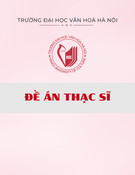


![Đề án Thạc sĩ: Tổ chức hoạt động văn hóa cho sinh viên Trường Cao đẳng Du lịch Hà Nội [Chuẩn nhất]](https://cdn.tailieu.vn/images/document/thumbnail/2025/20251202/kimphuong1001/135x160/91661764646353.jpg)
